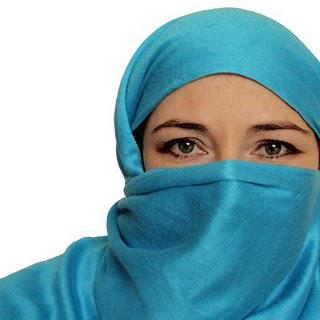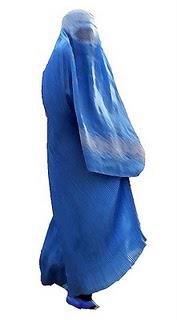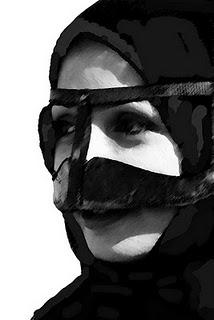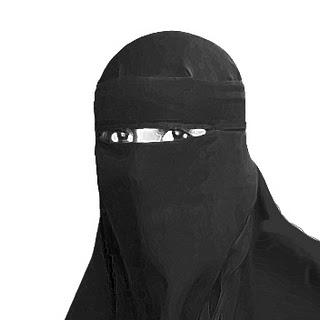
Australian Sheila in dress-ups
In Australia, "Sheila" is a term for a woman. It's fairly archaic now - generally only used by rusty old bogans from the outback, and rarely comes without the obligatory sexist smack on the bottom and a demand for a "frosty one from the icebox" (beer from the fridge). In the Middle East, a sheila is a head covering, pronounced with an "ay" vowel sound rather than "ee", and also spelled shaila, shela and shayla. You will see plenty of "Sheelas" in Australia, but "shaylas" are few and far between.In countries like Australia, France and the USA, any dress that covers more than what they deem “normal” is seen by some as a form of cruelty or domination. The first thing most Australians would think upon seeing a woman in traditional Arabic dress is "she's from a different world", followed by "that poor thing, her husband/father makes her dress like that" and "she must have a terrible life." And it's little surprise. Australia's Muslim minority only takes up about 1.5% of the total population, and many have assimilated to the point where conservative dress has been abandoned. The only time we see any traditional arabic dress is on TV, when we see Iraqi women wailing with grief over their son's bloodied bodies, or rows of Taliban-governed Afghan women in blue burqas with only a gauze for vision. Of course we associate it with misery and oppression.

Afghan burqa
When I first arrived in Dubai, I had never been to any part of the middle east. I remember the first trip to the Mall of the Emirates with my son Lion (then four years old), and he actually screamed when he saw a woman coming towards him in an abaya and a niqab - he thought she was a ghost. Only last night, I heard a full-grown man describe a beautiful, fragile woman in an abaya and hijab as "Darth Vader". And I, after three years of living surrounded by traditional dress, have only just started to look women in the eye if they wear a niqab - I suppose I had subconsciously assumed that because she covered so much, she did not want to be looked at. It does take getting used to. The abaya I love, but the fact that a woman will willingly cover her entire face is still alien to me - I would feel like I couldn't breathe or talk properly. The cloth on it's own would be a burdon, whether I was forced to wear it or not.
Lion (now 7) has finally become accostomed to the appearance, and Goldilocks (4) has always been accustomed - in fact, when I got Lion to take the photo of me above, Goldilocks was dancing around alongside declaring "Mummy Bootiful!"
So, for all my western readers, after hearing a little about it at the culural breakfast, I had an informal chat with an Emirati, a Saudi, and a crossed-culture muslim about this ever-so-oppressive dress. (I'm going to call them Cheryl, Barbara and Nolene respectively, because then you'll know they are not their real names)

Abaya with hijab (or shela)
Surprise, surprise, it turns out they have a choice.Cheryl wears an abaya (black, ground-length cloak, slightly tapered but not tight, closed at the front), and a hijab, or sheila (headscarf). When I visited her at home, she wore none of those things, and although she is very beautiful, I must say, the grace and stature she possesses when in traditional dress is lost. Cheryl wears the abaya because it is absolutely normal for her to do so, and only a small percentage of Emirati women don’t wear it at least most of the time. She says it is much like Indian women wear a saree or shalwr kameezes, and if she didn't wear it, she would position herself as a minority within her peer group. It is traditional dress as distinct from required by religion (it was around well before Islam, and worn by Jews and Christians before Muslims), and she never wears it while abroad (although some do).
Cheryl argues that contrary to feeling oppressed by it, that this form of attire opens doors for her. The treatment she receives at banks, airports and government offices is alone worth dressing up for. Cheryl has a choice of the style - for example, she chooses not to wear a niqab, and her abaya and hijab are adorned. There are many different shapes and styles to the abaya and the head covering, and it is easy to express one's individuality despite the fact they are all in head-to-toe black (One day soon we are going to go out spotting the abaya-wearing "tarts" and "geeks" and “bohos” over coffee). One day I saw her dressed for a wedding, and although out, she was not wearing the hijab, and had fuchsia detail on the collar and creeping down the front. Her height and the liquid nature of that adorned and billowy cloak made her set for the catwalk – I wasn’t the only one admiring her. Cheryl believes the burqa is considered quite old fashioned, and the niqab stereotypes the wearer as conservative, even by her.

UAE Traditional burqa
Her other reason for wearing traditional dress is that she feels elegant, and it's true - she, and other Emirati women who dress like her, look like they are going to a ball. It's probably the same reason that the traditional dress looks so funny when worn by women while exercising - to me it appears like they're jogging in haute couture.
Barbara wears western dress. And although I have never seen her in a tank top and short shorts, I would not even call it particularly conservative. In Jeddah, she wears an abaya and hijab, partially because she must, but again, because she does not want to stand out. In Saudi Arabia, quite distinct from the UAE, where adaptation of traditional dress by westerners is discouraged, all women are required to cover everything except for their faces and hands. Probably because she grew up with it, she does not feel oppressed by it, but she never, ever wears traditional dress out of Saudi Arabia. She recalled stories of her youth of bathing in shorts and t-shirts on the sun-drenched Jeddah foreshore, but she's not so sure if that would be tolerated now – the religious police are finding more power every day. She used to enjoy the freedom of wearing an abaya, and because it covered everything underneath, she could do the shopping in her pajamas.

Niqab
Noelene dresses in conservative western dress and wears only a sheila. It is almost part of her skin, and I have only once seen her without it. She wears it because her faith dictates it, and she is very happy with her chosen faith. In fact, she is the only one that mentioned Islam when explaining why she wears the sheila. And after all, the Quran only suggests modest dress and the covering of the bosom, not a full-body sheath. She sees no problem with her chosen form of modesty, enjoys it, and treats it like an accessory, different colours, textures, ornamentation.All women said that contrary to belief that their fathers or husbands made them go "behind the veil" so to speak, they make their own decisions on this. So these women are far from oppressed, but this is not an area ruled by religious police or the Taliban. And so I would suggest that the women subjected to the rules in countries such as these are not oppressed by their religion, but by men, probably the same kind of men that are happy to dominate people in any other way they can find, not with just attire, but freedom in all its forms. I have never been to a country under this kind of rule, and despite a fairly open mind, I doubt I ever will.
Also, I would argue that although the women say they don't feel forced to wear this form of dress (except for Barbara when she is in Saudi Arabia), their community or peers make quite strong demands upon them. If any were to buck against this trend, would they (particularly Cheryl) label themselves as revolutionary, or in the least, a controversial drama queen?
-------------------------------------------
for those who would like a rundown on the names an types of traditional Arabic dress, go here.
Leave me a comment and make my day...
